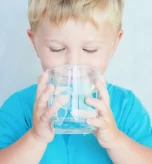Disinfection of drinking water is one of the greatest public health achievements in the last 100 years. Its use, starting in the early 1900s, helped tackle cholera, typhoid and other microbial diseases.
But it’s a double-edged sword, because it can also produce potentially harmful contaminants.
These contaminants, known as disinfection byproducts, or DBPs, can often be found in drinking water whose sources are not well protected from pollutants such as animal manure.
Some of the byproducts can increase the risk of cancer
and harm to the developing fetus. And many types of contact with disinfected water can expose a person to DBPs – everything from drinking tap water to eating food prepared with it, and swimming or bathing in it.
The best way to reduce the level of DBPs in water is to cut the amount of contamination in water before it arrives at a utility’s treatment plant. That requires curbing the amount of agricultural waste that gets into the water in the first place.
Federal standards exist for some but not all byproducts. A 2024 study uncovered a previously unknown byproduct detected in systems that together serve more than 100 million people. A 2025 study
suggests that current standards may fail to protect against cancer in the general population.
The problem with byproducts
Scientists have found more than 600 types of disinfection byproducts in water, and some are linked to harm to the developing fetus as well as cancer and DNA damage.
Total trihalomethanes, or TTHMs, and haloacetic acids, or HAA5, are two groups comprising some of the disinfection byproducts most prevalent in tap water. Exposure to these contaminants can increase the risk of cancer like bladder cancer and colorectal cancer.
Disinfection byproducts also increase the risk of problems during pregnancy, including miscarriage, cardiovascular defects, neural tube defects and low birth weight.
The byproducts are not added to water. Rather, they form during what is typically the last stage of water treatment, when chlorine, chloramine and other disinfectants are added, ensuring the water is free from disease-causing pathogens.
But these chemicals can react with organic matter like animal manure and soil particles, producing DBPs.
Some water utilities have moved from chlorine to alternatives such as chloramine, chlorine dioxide and ozone, which reduce TTHM and HAA5 formation. The long-term health consequences of exposure to chloramines and chloramine byproducts are not well understood.
But studies show these alternative disinfectants can form other byproducts that may also harm human health.
A 2024 study
identified the previously unknown byproduct chloronitramide anion in systems using chloramine – which describes systems supplying tap water for about 113 million Americans. This byproduct hasn’t been studied for its toxic effects, but its chemical structure suggests it may be harmful in the same way as other byproducts.
Are disinfection byproducts regulated?
The Environmental Protection Agency has set maximum allowable levels for some DBPs, including four TTHMs, HAA5, chlorite and bromate. These DBPs are found in water systems large and small throughout the country, especially those that draw on surface water as a source.
EWG’s health-based guidelines for DBPs are much lower than federal limits. In developing these guidelines, EWG scientists reviewed the best and latest scientific evidence and health advisories. They’re based largely on the California Office of Environmental Health Hazard Assessment’s health goals, which state that the levels of a drinking water contaminant must not pose a significant health risk.
Some utilities try to comply with the EPA’s standards by using alternative disinfectants. But studies show these can also form harmful byproducts, though they might not be subject to federal limits.
The EPA and individual states can step up by not only strengthening the few limits in place for byproducts but also pursuing first-time standards for a host of unregulated ones.
Reducing byproducts in tap water
Some strategies can help to decrease the formation of DBPs in treated drinking water. These measures include agricultural practices to protect source water before it gets to the treatment plant, including buffer zones near rivers and streams to reduce fertilizer and soil runoff.
Other measures at the treatment plant include carbon filtration as well as improvements to the distribution system, such as flushing and maintaining pH to reduce byproduct formation.
What can I do to lower my exposure?
One way to reduce your exposure to DBPs is to filter your drinking water. A simple carbon filter can be quite effective – and it’s especially important to use during critical life stages, such as during pregnancy.
You can find out more about your water – including whether it’s contaminated with DBPs or other toxic chemicals – by entering your ZIP code into EWG’s Tap Water Database. You can also get advice on the best type of filter to use for the specific pollutants present.






